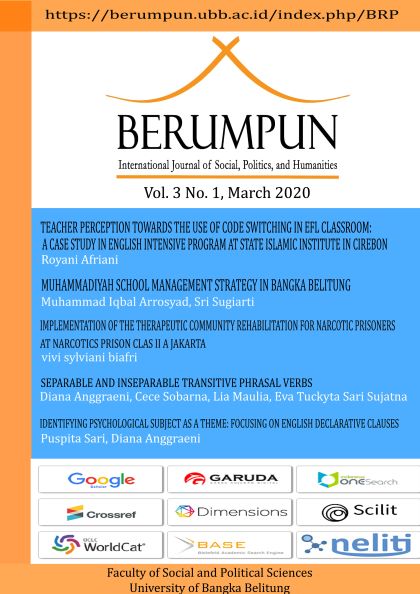TEACHER PERCEPTION TOWARDS THE USE OF CODE SWITCHING IN EFL CLASSROOM: A CASE STUDY IN ENGLISH INTENSIVE PROGRAM AT STATE ISLAMIC INSTITUTE IN CIREBON
DOI:
https://doi.org/10.33019/berumpun.v3i1.22Keywords:
Code switching, Perceptions, EFL classroomAbstract
The present study is descriptive qualitative research. The study aims to investigate and show the teachers perceptions toward the use of code-switching (CS) used by teachers in EFL classroom, especially in English intensive program at a State Islamic Institute. A four-section 20-item questionnaire was developed and distributed to the teachers. The data from the questionnaire were analyzed. The results display that teachers' perceptions are positive towards the use of code-switching in the EFL classroom. Teachers believe that the use of code-switching could help them in eliciting content, manage the classroom, and show interpersonal relations in the classroom. However, the use of code-switching is beneficial for learners but it also needs limitation because it could damage the process of language acquisition as learners don't get comprehensive input.
Downloads
References
Bashir, A., & Author, C. (2015). The Functions of Code Switching in ESL Classroom Discourse. Journal of Literature, Languages and Linguistics, 6, 6-9.
Benson, E. (2001). The Neglected Early History of Codeswitching Research in the United States. Language & Communication, 21, 23-36.
Bhatti, Aisha., Shamsudin, Sarimah., & Seriaznita. (2018). Code-Switching: A Useful Foreign Language Teaching Tool in EFL Classrooms. English Language Teaching; Vol. 11, No.6.
Cole, S. (1998). The use of L1 in communicative English classrooms. [Online] Available: http://langue.hyper.chubu.ac.jp/jalt/pub/tlt/98/dec/cole.html/file.
Cook V. (2000). Second language learning and language teaching. Beijing: Foreign Language Teaching and Research Press and Edward Arnold (Publishers) Limited.
Cook, V. (2001). Second Language Learning and Language Teaching. London: Arnold.
Cummins, J. & M. Swain. (1986). Bilingualism in Education. Harlow: Longman.
Ferguson, G. (2003). Classroom code-switching in postcolonial contexts: Functions, attitudes and polices. AILA Review, 16, 38-51.
Greggio, Saionara. (2007). Teachers and learners use of code switching in the English as a foreign language classroom: a qualitative study. Linguagem & Ensino,v.10,
Gulzar, M. A. (2010). Code-switching: Awareness about Its Utility in Bilingual Classrooms. Bulletin of Education and Research, 32(2), 23-44.
Iqbal, Liagat. (2011). Linguistic Features of CodeSwitching: A Study of Urdu English Teachers Classroom Interactions. Unpublished Ph.D. Scholar, International Islamic University.
Metila, R. A. (2009). Decoding the Switch: The functions of codeswitching in the classroom. Education Quarterly, 67(1), 44-61
Muysken, P. (2000). Bilingual Speech. A Typology of Code-Mixing. Cambridge: CUP.
Puspawati, Indah. (2018). Teachers Use of Code Switching in EFL Classroom and its Functions. Journal of Foreign Language Teaching & Learning, Vol.3 No. 1.
Schmitt, N & M, McCarthy, eds. (1997). Vocabulary: Description, Acquisition and Pedagogy. Cambridge: Cambridge University Press.
Wardhaugh. (2000). An introduction to sociolinguistics. Beijing: Foreign language teaching and Research Press.
Willis, J. (1981). Teaching English through English. Harlow: Longman.
Yao, Mingfa. (2011). On Attitudes to Teachers Code-switching in EFL Classes. World Journal of English Language, Vol . 1, No. 1.




